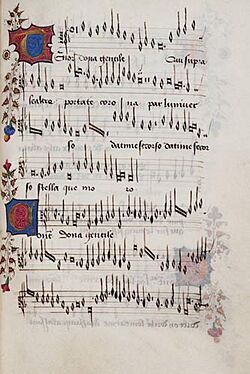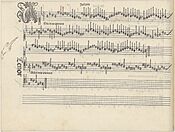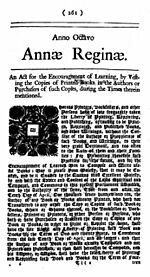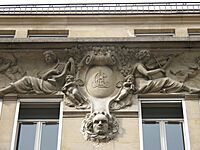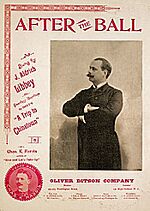History of music publishing facts for kids
Music publishing is a business that helps create, produce, and share printed music like sheet music and songbooks. It also makes sure that the people who wrote the music, like composers and songwriters, get credit and money for their work. This article will tell you about how music publishing started and grew over time.
Contents
How Music Was First Printed
Music publishing really began to grow in the mid-1400s. This was when new ways to print music using machines were invented. One of the very first examples is the Mainz Psalter from 1457. It was the second book ever printed on the famous Gutenberg press.
Before the 1500s, only rich people or churches owned music books. Most music had to be learned by listening or copied by hand. Copying music by hand took a lot of time and effort. So, at first, only monks and priests did this to save sacred music for the church. A few collections of non-religious music were made for wealthy nobles. Even after printing was invented, people still copied music by hand for a long time, even into the 1700s.
Ottaviano Petrucci: A Printing Pioneer
A very important person in early music printing was Ottaviano Petrucci. He was a printer and publisher who lived in Venice in the 1500s. He managed to get a special right to be the only one to print music in Venice for twenty years!
His first collection of music was called Harmonice Musices Odhecaton. It had 96 songs with many different parts playing at once, mostly by composers like Josquin des Prez and Heinrich Isaac. Petrucci became successful by printing music from Flanders (a region in Europe), which was very popular across Europe during the Renaissance.
His printing shop used a special "triple-impression" method. This meant a sheet of paper was pressed three times. First, the staff lines (the lines music is written on) were printed. Then, the words were added. Finally, the notes were printed. This method made the music look very neat, but it took a lot of time and cost a lot of money.
John Rastell: A Simpler Way to Print
Around 1520, in England, a man named John Rastell found a faster way to print music. His method used only one impression. This meant the staff lines, words, and notes were all printed at the same time. This made it much easier to produce music.
However, Rastell's method sometimes made the music look a bit messy. The staff lines might not line up perfectly and could look wavy. Even so, this single-impression method eventually became more popular than Petrucci's. It was the main way music was printed until the 1600s, when copper-plate engraving took over. A French printer named Pierre Attaingnant also used this single-impression method a lot.
Protecting Music: The Idea of Copyright
The idea of copyright for music started in England during the time of King Henry VIII. He wanted copies of all printed materials sent to him. He also offered protection to printers with special licenses, which helped him earn more money.
In 1575, Queen Elizabeth I gave two composers, Thomas Tallis and William Byrd, a special right for 21 years. This right meant only they could print and publish music with many different parts.
The first modern copyright law was the Statute of Anne in 1709. This law protected all published works for 14 years. Later, this was extended to 28 years. The very first time a printed music piece had a copyright warning was in ""Shir Hashirim"" by Salomone Rossi in 1623. It even had a religious warning against copying the text without permission.
The Berne Convention: Copyright Around the World
The first international agreement about copyright was the Berne Convention in 1886. The main idea of this agreement was that countries that signed it would automatically protect works from other signing countries. This included protecting the rights to perform music. By 2012, 165 countries had joined this agreement.
Copyright in the United States
The first U.S. federal copyright law in 1790 protected "maps, charts, and books." Even though it didn't specifically say "music," it did cover musical compositions. The first music piece registered for copyright in the U.S. was "The Kentucky Volunteer" in 1794.
However, musical compositions were not clearly protected until the Copyright Act of 1831. Even then, the protection was mostly for making copies. Copyright lasted for 28 years, with a chance to renew for another 14 years.
Performing Rights: Getting Paid for Performances
While England led the way in copyright, France was a leader in "performing rights." These rights mean that composers get paid when their music is performed publicly.
In 1777, Pierre de Beaumarchais started a group that later became the Société des Auteurs et Compositeurs Dramatiques (SACD) in 1829. Many years later, in 1847, a composer named Ernest Bourget demanded payment for his works being performed at a popular cafe-concert in Paris. He and others won a lawsuit in 1851. This led to the creation of the Société des Auteurs, Compositeurs et Editeurs de Musique (SACEM). This was the first group in the world to protect performing rights for music.
Other countries soon followed. Italy's SIAE started in 1882, and Spain's SGAE began in 1899. In Germany, composer Richard Strauss helped form a group in 1903 that later became GEMA in 1915. By the end of the 1800s, the basic ideas for the modern music publishing industry were in place.
Music Publishing in the 1700s
German Music Publishers
Germany was a leader in modern music publishing. The first German music publishing companies started in the 1700s. Bernhard Christoph Breitkopf in Leipzig began to focus on music printing in 1754. He became successful by making better ways to set music type.
In 1795, Gottfried Christoph Härtel joined the company, and it became Breitkopf & Härtel. They were the first publishers for many famous German composers, including Beethoven, Haydn, Mozart, Schubert, Schumann, and Wagner.
Schott Music in Mainz was founded in 1770 by Bernhard Schott. This company still exists today! They focused on French and Italian operas. More recently, they have published works by composers like Hindemith and Stravinsky. N. Simrock started in Bonn in 1790. They published works by Beethoven, Haydn, Mendelssohn, and Brahms.
Music Publishing in the United States
In 1764, Josiah Flagg put together the first collection of popular and religious music printed in the American colonies. After the American Revolution, the first professional music publishers from Europe arrived in the 1770s. They opened shops in cities like Philadelphia and New York, bringing European printing technology with them. Benjamin Carr and James Hewitt were two important early American music publishers.
In the early 1800s, U.S. publishers printed about 10,000 pieces of popular music. However, the industry didn't really promote music or help writers. Songs became popular mostly by people telling each other about them. Many minstrel groups and singers wrote their own music.
Stephen Foster was the first composer who tried to make a living just by writing songs. But in the 1850s, copyright laws were weak, and he earned very little money. He ended up living in poverty. This slowly changed as young business people saw how much money could be made from publishing songs.
Before the 1880s, popular music publishing was often a side job for music stores or classical music publishers. After 1880, publishers in New York developed a way to promote songs called "plugging." By 1900, most music publishers were located on 28th Street in New York City. This area became known as Tin Pan Alley.
In the first ten years of the 1900s, more popular music was created than ever before, about 25,000 songs each year. In 1893, the sheet music for the song "After the Ball" sold one million copies. Over the next ten years, it sold a total of ten million copies!
Even with new U.S. copyright laws, like the 1891 Chace Act for international copyright, the rules of the 1909 Copyright Act were often ignored. To fix this, composer Victor Herbert started the American Society of Composers, Authors and Publishers (ASCAP) in 1914. Famous composers like Irving Berlin quickly joined. ASCAP helped make sure everyone was paid and credited correctly for their work.
Music Licensing: How Music Is Used Today
Music publishing has many parts. A big part is "licensing" music. This means giving permission for music to be used in ads, TV shows, movies, and other ways. Music publishing started with just printing sheet music. In the 1800s, sheet music began to include simple piano music and the song's tune.
Today, music publishing is about letting people use songs and other music for many different things. This includes licensing for video games, for recording artists who want a new hit song, and for many other uses.
Types of Music Licenses
There are several different types of licenses in music publishing:
- Blanket license
- Mechanical license
- Performing Rights License (PRO)
- Synchronization License (Sync Rights)
A blanket license is a yearly fee paid to a performing rights organization (PRO) like SESAC, ASCAP, or BMI. This license lets the user play any song from that PRO's entire collection. TV networks and radio stations often use blanket licenses. This way, they can play any song from a catalog without paying for each song separately.
A mechanical license is needed when a recording artist wants to sell their recording of a song. It tells the song's owners that sales are happening and that they will be paid royalties (a percentage of the sales).
A Performing Rights License (PRO) gives someone the right to perform a song or music piece in public.
Finally, a sync license gives permission to use a song with moving pictures, like in a movie, an advertisement, a TV show, or any other video. For the same use, you also need a "master use license." This license gives you the right to use the actual sound recording, which is owned separately from the song itself.
A music publisher helps songwriters and composers get paid for these uses. In recent years, music publishing companies have become a main way for artists to earn money, besides live concerts. This is because sync licensing has remained a good source of income, even as record sales have gone down.
New Technologies and Music Publishing
Sound Recording Changes Everything
When sound recording was invented, it completely changed what "publishing" music meant. It was a big change, just like online music stores changed how we buy music later on.
At first, popular music was slow to use this new technology. In 1910, when sales of new disc records became higher than old cylinder records, more than 75% of the records sold were classical music. This might have been because records were expensive, so mostly richer people bought them.
Until 1925, selling sheet music still brought in more money than selling records. Sheet music was the main way publishers and composers earned money. After that, sheet music sales started to drop, and records weren't making enough money to make up for it. This caused some serious money problems for certain publishers for a short time.
Music in Movies
Samuel Fox, who started the Sam Fox Publishing Company in 1906, was the first to publish original music written for films. In 1927, after The Jazz Singer (the first movie with spoken dialogue) came out, movie studios needed a lot of music. So, they started buying music publishing companies. This gave them both a lot of existing music and experienced composers.
For example, in 1929, Warner Brothers paid $10 million for several music companies. MGM bought Leo Feist Inc. and other smaller companies. Paramount even started its own music publishing division called Famous Music.
See also
- Music engraving
- Music publisher (popular music)
- Music publisher (sheet music)
- Sheet music
- Copyright
- Universal Circulating Music Library
- List of women music publishers before 1900
- List of best-selling sheet music
- Record label


